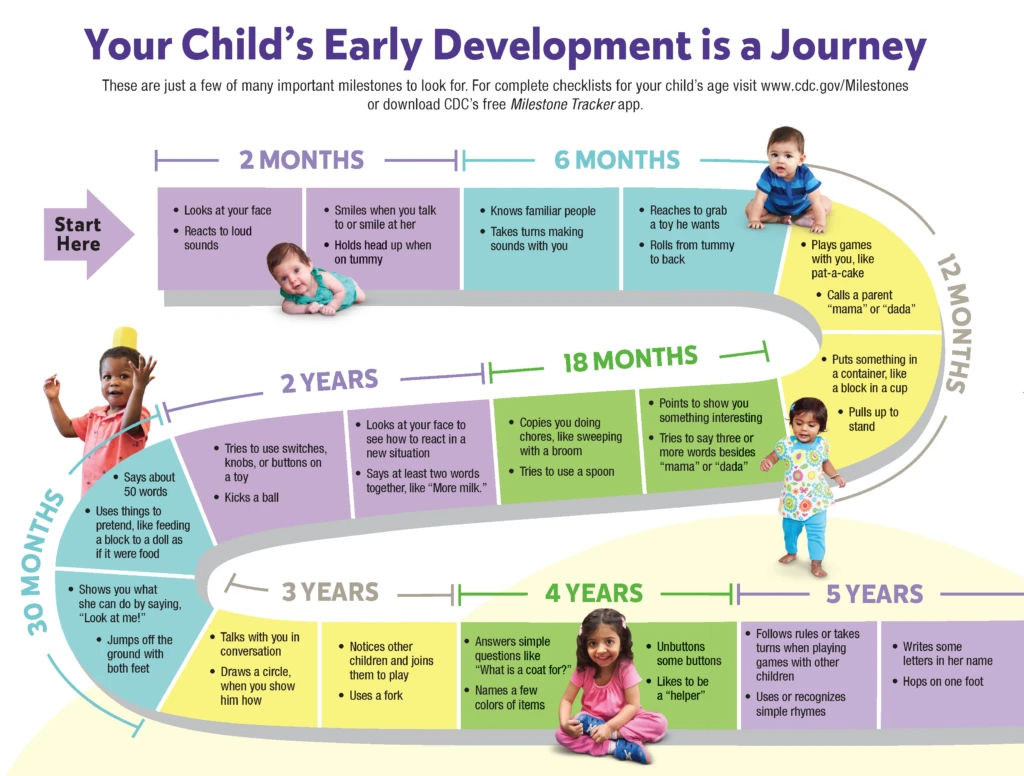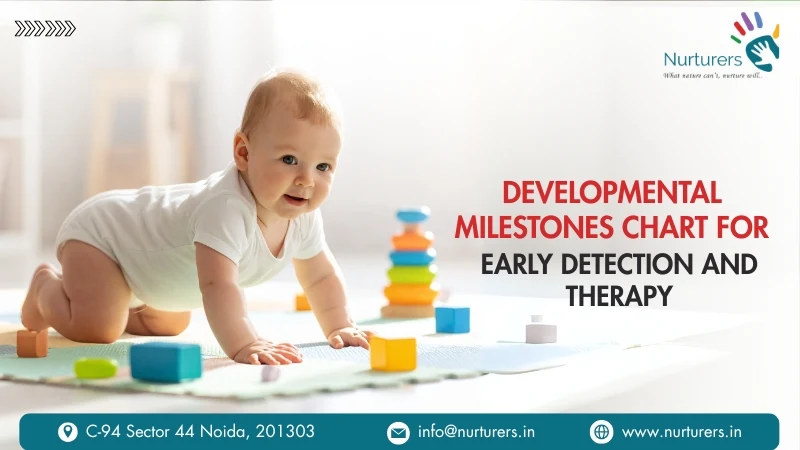Understanding a child’s growth and development is crucial for ensuring they reach their full potential. A Developmental Milestones Chart serves as a comprehensive guide for parents, caregivers, and healthcare professionals to track a child’s physical, cognitive, social, and emotional progress from infancy through early childhood. These charts outline developmental milestones in areas such as gross motor developmental milestones, fine motor developmental milestones, language, and social skills.
Early detection of delays is vital because it allows timely intervention, significantly improving a child’s long-term outcomes. By monitoring these milestones, caregivers can identify developmental milestones and understand potential causes of delayed developmental milestones, enabling them to seek professional assessment and therapy when needed. Many resources are available, including developmental milestones PDFs that provide structured, easy-to-use references for home monitoring and clinical settings.
What Are Developmental Milestones?
Developmental milestones are age-appropriate skills that children acquire as they grow. These milestones are grouped into several areas:
- Gross motor developmental milestones: Skills that involve large muscle groups, like rolling over, crawling, walking, running, and jumping. These milestones are crucial for physical strength, coordination, and balance.
- Fine motor developmental milestones: Skills that involve small muscles, particularly in the hands and fingers, such as grasping toys, drawing, stacking blocks, and using utensils. Fine motor skills are closely linked to cognitive and hand-eye coordination development.
- Language and communication milestones: Skills such as babbling, forming words, using sentences, understanding instructions, and communicating needs.
- Cognitive milestones: Problem-solving, reasoning, memory, attention span, and ability to learn new concepts.
- Social and emotional milestones: Forming relationships, expressing emotions, empathy, cooperation, and adapting to social situations.
By observing and tracking these milestones, parents and caregivers can identify whether a child is developing typically or if intervention may be needed.

Why Use a Developmental Milestones Chart?
A developmental milestones chart is a visual guide to help parents track their child’s progress. It shows which skills are expected at different ages and helps detect developmental milestones and red flags early.
Benefits include:
- Early detection: Spotting delays in physical, cognitive, or social skills before they become more serious.
- Better communication with specialists: Pediatricians, therapists, and educators can better understand a child’s needs when parents provide structured observations.
- Planning early interventions: Timely therapy can significantly improve outcomes for children with delays.
- Tracking progress: Parents can monitor improvements over time and celebrate small achievements.
For ease of use, a developmental milestones PDF is available for parents, allowing them to track progress at home.

Key Developmental Milestones by Age
Tracking developmental milestones is critical for understanding your child’s growth. Here’s a detailed overview, including examples of typical skills, activities to encourage development, and what to watch for:
Infants (0–12 months)
Gross motor developmental milestones:
- Lifting head while on tummy (around 3 months): Encourage tummy time to strengthen neck and shoulder muscles.
- Rolling over (4–6 months): Helps improve coordination and mobility. Use soft mats for safe practice.
- Sitting without support (6–8 months): Provides stability for reaching and exploring objects.
- Crawling (7–10 months): Enhances coordination and strengthens arm and leg muscles.
- Pulling up to stand (9–12 months): Prepares for walking; ensure a safe environment with stable furniture.
Fine motor developmental milestones:
- Grasping toys (3–4 months): Place colorful toys within reach to encourage hand-eye coordination.
- Transferring objects between hands (5–6 months): Promotes bilateral coordination and object recognition.
- Pincer grasp (9–12 months): Picking up small items with thumb and forefinger; supports later skills like self-feeding and drawing.
Language and cognitive milestones:
- Babbling and cooing: Respond to sounds to encourage early communication.
- Responding to name: Helps develop social awareness and attention.
- Imitating sounds: Encourages early speech development; singing nursery rhymes or reading aloud helps.
Social and emotional milestones:
- Smiling at familiar faces: Early bonding and social connection.
- Recognizing caregivers: Promotes attachment and emotional security.
- Showing interest in surroundings: Encourages curiosity and exploration.
Tip: Use a developmental milestones chart to note when your infant achieves each skill for early detection of any delays.
Toddlers (1–3 years)
Gross motor developmental milestones:
- Walking independently: Provide safe spaces to explore and practice walking.
- Running and climbing stairs: Helps improve balance, coordination, and confidence.
- Kicking a ball: Supports leg strength and coordination; try simple games like rolling a ball back and forth.
- Jumping with both feet off the ground (around 2–3 years): Enhances leg strength and balance.
- Throwing overhand: Improves hand-eye coordination and spatial awareness.
Fine motor developmental milestones:
- Scribbling: Encourages creativity and strengthens hand muscles.
- Building towers with blocks: Develops problem-solving and fine motor precision.
- Feeding themselves: Supports independence and fine motor control.
- Turning book pages: Encourages coordination and reading readiness.
- Stacking rings or simple puzzles: Promotes problem-solving and concentration.
Language and cognitive milestones:
- Using 2–3 word sentences: Helps in expressing needs and thoughts.
- Following simple instructions: Develops comprehension and memory skills.
- Identifying familiar objects and people: Supports early cognitive mapping and recognition.
- Understanding basic concepts like “in” and “out”: Encourages reasoning skills.
Social and emotional milestones:
- Showing independence: Encouraging small choices like picking clothes or toys builds self-confidence.
- Playing alongside other children (parallel play): Early socialization builds empathy.
- Expressing preferences and emotions: Helps parents understand the child’s needs and personality.
- Beginning cooperative play: Sharing toys or taking turns during simple games.
Causes of Delayed Developmental Milestones
Several factors can contribute to delayed milestones:
- Premature birth or low birth weight – Babies born early may develop at a slightly slower pace.
- Genetic or neurological conditions – Conditions like Down syndrome or cerebral palsy can affect development.
- Environmental factors – Lack of stimulation, neglect, or insufficient opportunities to explore and play.
- Hearing or vision impairments – Can affect language, social interaction, and coordination.
- Chronic medical conditions – Recurrent illnesses can delay physical and cognitive growth.
Developmental Milestones Red Flags
Parents should watch for red flags for autism, which indicate the need for professional evaluation:
- No social smile by 3 months
- Not making sounds or gestures by 12 months
- Difficulty walking, using hands, or coordinating movements by 18 months
- Regression of previously acquired skills
- Limited interaction or eye contact
Identifying these signs early allows for timely therapy and intervention.
How Nurturers Supports Early Detection and Therapy
At Nurturers, we specialize in providing comprehensive early detection and therapy for children with delayed milestones. Our approach includes:
- Conducting detailed assessments using developmental milestones charts
- Personalized therapy plans for fine and gross motor skills, speech, cognitive, and social-emotional development
- Guidance for parents to continue interventions at home
- Regular monitoring to track progress and adjust therapy plans
Our goal is to ensure children reach their full potential through early and targeted support.
Practical Tips for Parents
- Use a developmental milestones PDF to track your child’s progress regularly.
- Observe your child in different settings – home, playground, daycare – for a complete picture.
- Encourage play-based learning to strengthen fine and gross motor skills.
- Consult specialists immediately if you notice any developmental milestones red flags.
- Celebrate every achievement to build confidence and motivation.
Conclusion
Monitoring developmental milestones is vital for early detection of delays and effective therapy. A developmental milestones chart or PDF is an essential tool for parents to track physical, cognitive, and social growth. At Nurturers, we provide expert guidance, assessment, and therapy to help children thrive. Early intervention is key, and the sooner delays are detected, the better the outcomes for your child.

